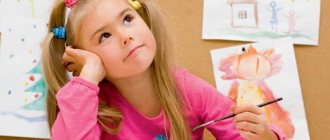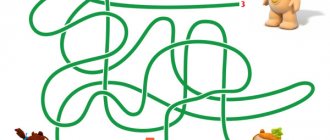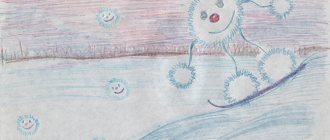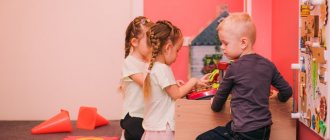Imagination is an extremely important mental process, but insufficient attention is usually paid to its development in preparation for school. Finding a non-standard solution to a problem, composing a story, writing an essay, doing creative work or coming up with an interesting research project - all this is impossible without a fairly good imagination. You can develop the imagination of preschool children with the help of various exercises and games, which will be discussed in this article.
On the characteristics of imagination in preschool children
In children, as in adults, experts distinguish the following types of imagination:
- Recreating. This type of imagination is inextricably linked with memory and imaginative thinking. With its help, a person can imagine what he heard or read about in a book.
- Creative imagination is the creation of new images by modifying already familiar ones (based on acquired experience).
- As a result of uncontrolled imagination, a person develops ideas that are not associated with any logic.
A person with a well-developed imagination has extraordinary creative thinking, which allows him to cope with various tasks more easily than others. Therefore, it is very important to encourage the child’s imagination and original solutions.
At preschool age, the imagination is most developed, because it is still difficult for children to act according to given rules. Imagination, like other mental processes, actively develops through play. While playing, children come up with new stories and use substitute objects (that is, a piece of paper becomes a movie ticket or a TV remote control becomes a mobile phone). Fantasy develops more actively if the child’s life is full of various events and vivid emotions, because new ideas are created on the basis of existing experience. It is also important to note that children often literally live in their own imaginary world and may confuse fantasy and reality. You need to carefully monitor the baby’s behavior and promptly introduce him to the real picture of the world in cases where this is necessary (for example, that you should not run out onto the road or stick your fingers into a socket).
Types of imagination
Imagination is an integral element of a person’s ability for abstract thinking - it helps to recreate images along separately existing links, plan events, create goals and find ways to achieve them. However, this process is not always subject to the desire of a person or is completely under his control. More often, a person deals with so-called passive manifestations of fantasies that are not destined to be realized in the near future.
This is for example:
- dreams - refer to conscious thought processes, when an individual most clearly imagines the desired images and events;
- dreams - can be created consciously or semi-consciously, and also represent desired moments that are never destined to come true for a number of different reasons;
- hallucinations - an unconscious vision of non-existent visual images of a fantastic or adaptive nature, the reality of which the individual does not doubt;
- dreams are a completely unconscious process that is activated in a person’s state of rest.
Active types of imagination are the processes of controlled evocation of the necessary images. There are also several of them:
- creative (productive) imagination – forms images or scenarios (algorithms) of events, later embodied in real objects or accomplishments;
- recreating is a kind of “memory archive” that stores and mentally restores, at the request of a person, images and facts that took place in the individual’s past.
Every mentally healthy person has an imagination that is developed to one degree or another, but if desired, the ability to operate abstractly can be strengthened, thereby revealing new potentials and previously unknown possibilities.
Games and exercises for developing imagination in preschoolers
- “What would happen if...” This word game perfectly develops the imagination of preschoolers. Ask your child what would happen if, for example, cars flew or adults became small and children became big, and so on. The topic can be absolutely anything, and the questions themselves can be funny and absurd - this will only further motivate the child to think creatively.
- "Tall tales." This exercise is similar to the previous game. But instead of asking questions, the adult voices the beginning of the story, and the child must continue it so that something unprecedented turns out. As a visual support in this game, you can use various plot pictures, illustrations, newspaper and magazine clippings, as well as drawings by the child himself. Telling stories is an extremely powerful way to develop your creative imagination.
- "Magic box" Children love dress up games. Place old clothes, masks, hats and other accessories in a box. Together with your baby, you can sew a real fancy dress costume from various materials. The child will be happy to put on a costume performance at home or have a fashion show.
Participate in your child’s games and come up with new stories together. This will not only help develop your baby’s imagination, but will also strengthen your relationship.
- "What does a cloud look like?" While walking with your baby, look around: look at the clouds, tree branches, shadows, puddles under your feet. Think about what they look like.
- “What can this thing be used for?” Invite your child to come up with as many ways as possible to use some simple objects (for example, a pencil, a piece of paper, a pebble, a sock, etc.). In a child's imagination, an ordinary glass can become a house for a bug, a signal light for a police car, or a musical instrument.
- Writing fairy tales. Together with the baby, compose a fairy tale on a topic that is close to the child. The presence in it of familiar plots and the child’s favorite characters are important factors necessary to captivate the child with the game.
- “Complete the figure.” Draw several geometric shapes on a piece of paper and ask your little one to add details to them so that each shape turns into an object.
- Blotography. A similar exercise can be performed using paints. Let your child put a colored blot on a piece of paper and then draw it into something meaningful.
- "Non-existent animal." This is not just a game, but a projective drawing test, which in the hands of a specialist can tell a lot about a child’s personality. At home, the task that underlies this technique will serve as an excellent way to develop the imagination of preschool children. Ask your child to come up with and draw an animal that does not exist (neither in life, nor in fairy tales, nor in cartoons) and give it a non-existent name. After the drawing is ready, discuss his work with your child: find out what kind of character the invented character has, what he likes to do and what he doesn’t, whether he has friends or enemies.
- Creative activities: drawing, modeling, appliqué.
Through creativity, children express their fantasies, feelings, thoughts and experiences. But in this case we are talking specifically about free creative activity, when the child decides for himself what he wants to depict. If we talk about coloring and making crafts based on patterns, then these activities only contribute to the development of fine motor skills and the ability to follow instructions, but not imagination.
- Construction. Every time your baby builds something new without using a pattern or instructions, he is using his imagination and learning to think creatively.
- Free role-playing play is the leading activity of preschoolers, therefore it is in it that all mental processes develop most actively and naturally. When playing with peers, children are in an imaginary situation with their own rules and distribution of roles.
Exercises for children 6-7 years old
In older preschool and primary school age, the embodiment of the child’s fantasies undergoes a transformation. Most of the imaginary plots and images born in the mind of a little person no longer find manifestation in play situations and creative self-expression, but are played out by the child in his mind. It is at this stage that it is important to help the young dreamer not to go headlong into the world of fictional images, but to subordinate his imagination to real goals and learn to produce ideas.
Exercises for developing imagination in younger schoolchildren can be as follows:
- "The Practice of L. N. Tolstoy." The child is shown any object familiar to him (notebook, lamp, table) and asked to imagine as if he came from a distant country, where no one knows anything about the purpose of this object. What accessible concepts could a foreigner use to describe the thing he saw and what meaning would he give to it?
- "Picture Alive" First, the parent and child should imagine that they have received the amazing ability to bring to life everything that they draw on paper. You can start with simple images - the sun, a cloud, a flower, and then move on to more complex objects - fictional characters, ancient animals, buildings. How will the revived objects behave, will they need adaptation, what new properties will they manifest?
- "Magical forest". With the parent's hand, 3-4 trees standing separately are drawn on a large sheet of paper, and all the free white space is filled with chaotically scattered dots and strokes. The preschooler is given the task of finishing the forest on paper, using all the random elements in the drawing, and then talking about its wonders.
Often in children's magazines or educational workbooks you can find game tasks “Continue the drawing”. The child is given one simple element in the form of a large letter or number (geometric figure, broken line), which is asked to develop into an independent image. This imaginative exercise teaches preschoolers to think logically and improves fine motor skills.
conclusions
The modern world requires a person to be able to find non-standard solutions to problems. Already in elementary school, the child is faced with tasks that require a creative approach to successfully complete. Preschool age is considered the most favorable for the development of imagination. To do this, there are many games and exercises in which kids need to independently come up with something new and unusual. And don’t forget to set an example for your child, because children copy the behavior of adults: play and fantasize with your baby.
Books for developing children's imagination (for parents)
| Book title | book author |
| Preschool psychology. | Uruntaeva G.A. |
| Developing imagination in children: a popular guide for parents and teachers. | Subbotina L.Yu. |
| Development of creative imagination in children. | Solovey L.B. |
| Study of imagination and creativity of preschool children in foreign psychology // Preschool education. | Sinelnikov V. |
| Down the rabbit hole: metamorphosis and nonsense in children's imagination // Questions of psychology. | Sapogova E.E. |
| Psychology of a preschooler. Reader. | G.A. Uruntaeva. |
| Fantasy playgrounds // Preschool education. | Preusler O. |
| Fantasy and reality. | Petrovsky A.V. and etc. |
| Development of imagination in children of the second year of life // Preschool education. | Palagina N. |
| Psychology of a preschooler. | Mukhina V.S. |
| Preschool child: a new approach to diagnosing creative abilities // Preschool education. | Kudryavtsev V., Sinelnikov V. |
| Development of imagination // Preschool education. | Kravtsova E. |
| Imagination and its role in cognition. | Korshunova L.S. |
| Games and exercises for the development of mental abilities in preschool children: Book. for a kindergarten teacher garden | L.A. Wenger, O.M. Dyachenko. |
Exercises to develop imagination for adults
A well-developed imagination is characterized primarily by a emancipation of consciousness, which cannot be achieved if one thinks in standard clichés. Is a rapana shell brought back from vacation good only to become an ashtray? Filled with soil mixture and secured with the hole facing up, the shell easily turns into a mini-pot for a dwarf cactus. Or, varnished, it forms the basis of a marine installation. How many other items in the house are “out of place”?
In addition to this simple mental training, which can be done anywhere, psychologists suggest using the following exercises to develop fantasy and imagination:
- "What if…". What if all the refrigeration systems in the world's supermarkets stopped working at the same time? What if the planet's air turns into laughing gas? By asking oneself such seemingly ridiculous questions and “expanding” them in detail to a comprehensive answer, a person learns to see ordinary things from an unexpected angle and find logical solutions in the most confusing situations.
- "Hidden meaning". This exercise in developing imagination from screenwriter Jean Peret can be played in your head every free minute when you have the opportunity to look through a magazine or image gallery on the Internet. You need to randomly open the first illustration you come across and try to come up with at least 10 humorous captions for it, revealing the secret meaning of the picture.
The now fashionable trend of dubbing foreign films with “goblin” translation is another great option to “upgrade” your idea of the normality of the world. When watching any film on TV, you just need to turn on the silent video mode and try to create your own version of the “voice acting” of the film. It may look stupid and even delusional, but with regular training, this exercise in developing imagination can transform an ordinary gray personality into a local humor star.
How to develop imagination as an adult
Plunging headlong into the routine of everyday worries, an adult consciously limits his vision of the world to the narrow framework of the events and images he needs. This does not mean that his ability to imagine is lost, but it becomes more and more difficult for him to realize it every year.
Exercises for developing imagination in adults are created taking into account the need to abandon the baggage of old patterns that force one to think in stereotypes. The consciousness of an adult is designed in such a way that when trying to think outside the box, a whole chain of defense mechanisms is activated in his head. For this reason, from the first days you should not try to devote more than 10 minutes at a time to exercises to develop your imagination.
It is advisable to start with simple observation in conditions close to everyday ones - for example, on the way home from work. Even a path traveled many times can be fraught with many surprises that will both amuse and shock you if you look at them more closely. An amusingly composed advertisement on the wall, the burning windows of a high-rise building forming alphabetic or numerical signs - once you open your mind to the unusual, your imagination will work with redoubled force.
Why do you need to develop imagination?
Adults understand that they need to develop the imagination of toddlers, but often do not know how to do it. Child psychologists say that a child with a developed imagination quickly understands new material, better assimilates the information received, and develops creative abilities. Such children, as a rule, grow up balanced and calm. They are able to make informed decisions and realize themselves in their chosen field. If you develop a child’s imagination from childhood, you can with a greater degree of confidence assume that he will grow up to be a creative person. This does not mean that the baby will become a musician, artist or actor in the future. Creative abilities help people of any profession: directors, architects, teachers, etc.






